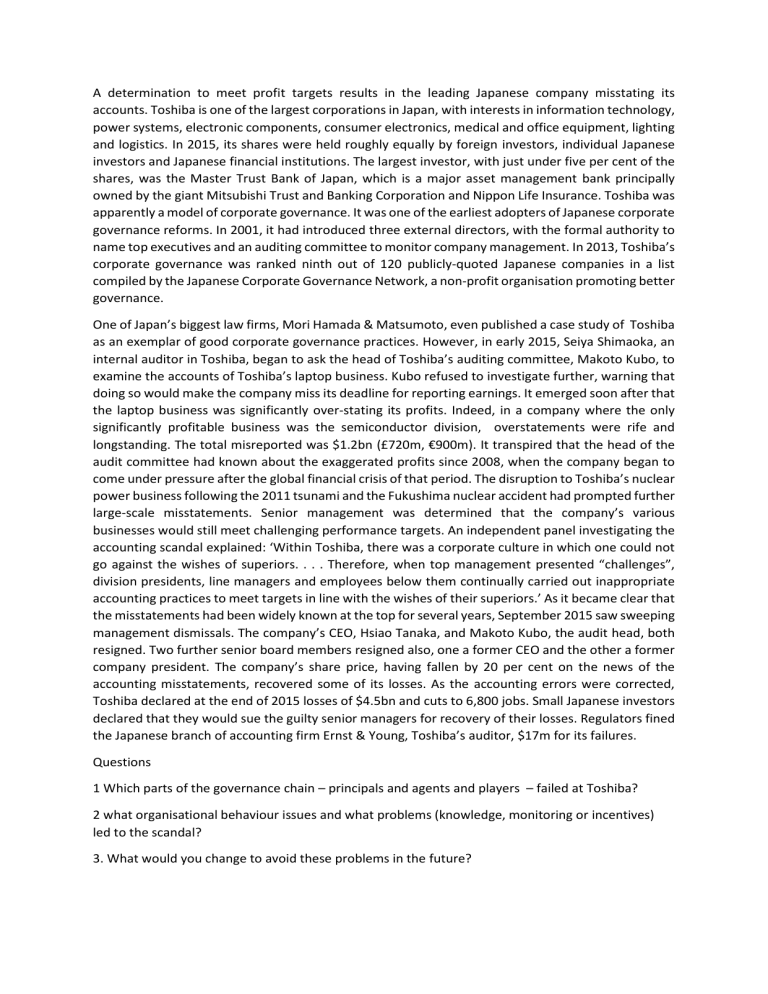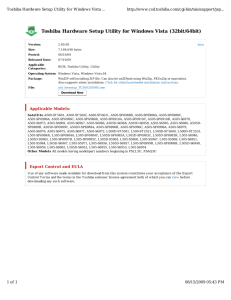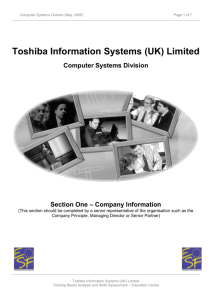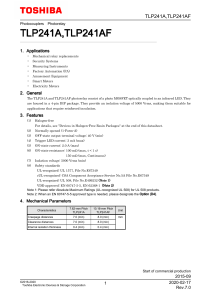
A determination to meet profit targets results in the leading Japanese company misstating its accounts. Toshiba is one of the largest corporations in Japan, with interests in information technology, power systems, electronic components, consumer electronics, medical and office equipment, lighting and logistics. In 2015, its shares were held roughly equally by foreign investors, individual Japanese investors and Japanese financial institutions. The largest investor, with just under five per cent of the shares, was the Master Trust Bank of Japan, which is a major asset management bank principally owned by the giant Mitsubishi Trust and Banking Corporation and Nippon Life Insurance. Toshiba was apparently a model of corporate governance. It was one of the earliest adopters of Japanese corporate governance reforms. In 2001, it had introduced three external directors, with the formal authority to name top executives and an auditing committee to monitor company management. In 2013, Toshiba’s corporate governance was ranked ninth out of 120 publicly-quoted Japanese companies in a list compiled by the Japanese Corporate Governance Network, a non-profit organisation promoting better governance. One of Japan’s biggest law firms, Mori Hamada & Matsumoto, even published a case study of Toshiba as an exemplar of good corporate governance practices. However, in early 2015, Seiya Shimaoka, an internal auditor in Toshiba, began to ask the head of Toshiba’s auditing committee, Makoto Kubo, to examine the accounts of Toshiba’s laptop business. Kubo refused to investigate further, warning that doing so would make the company miss its deadline for reporting earnings. It emerged soon after that the laptop business was significantly over-stating its profits. Indeed, in a company where the only significantly profitable business was the semiconductor division, overstatements were rife and longstanding. The total misreported was $1.2bn (£720m, €900m). It transpired that the head of the audit committee had known about the exaggerated profits since 2008, when the company began to come under pressure after the global financial crisis of that period. The disruption to Toshiba’s nuclear power business following the 2011 tsunami and the Fukushima nuclear accident had prompted further large-scale misstatements. Senior management was determined that the company’s various businesses would still meet challenging performance targets. An independent panel investigating the accounting scandal explained: ‘Within Toshiba, there was a corporate culture in which one could not go against the wishes of superiors. . . . Therefore, when top management presented “challenges”, division presidents, line managers and employees below them continually carried out inappropriate accounting practices to meet targets in line with the wishes of their superiors.’ As it became clear that the misstatements had been widely known at the top for several years, September 2015 saw sweeping management dismissals. The company’s CEO, Hsiao Tanaka, and Makoto Kubo, the audit head, both resigned. Two further senior board members resigned also, one a former CEO and the other a former company president. The company’s share price, having fallen by 20 per cent on the news of the accounting misstatements, recovered some of its losses. As the accounting errors were corrected, Toshiba declared at the end of 2015 losses of $4.5bn and cuts to 6,800 jobs. Small Japanese investors declared that they would sue the guilty senior managers for recovery of their losses. Regulators fined the Japanese branch of accounting firm Ernst & Young, Toshiba’s auditor, $17m for its failures. Questions 1 Which parts of the governance chain – principals and agents and players – failed at Toshiba? 2 what organisational behaviour issues and what problems (knowledge, monitoring or incentives) led to the scandal? 3. What would you change to avoid these problems in the future?




